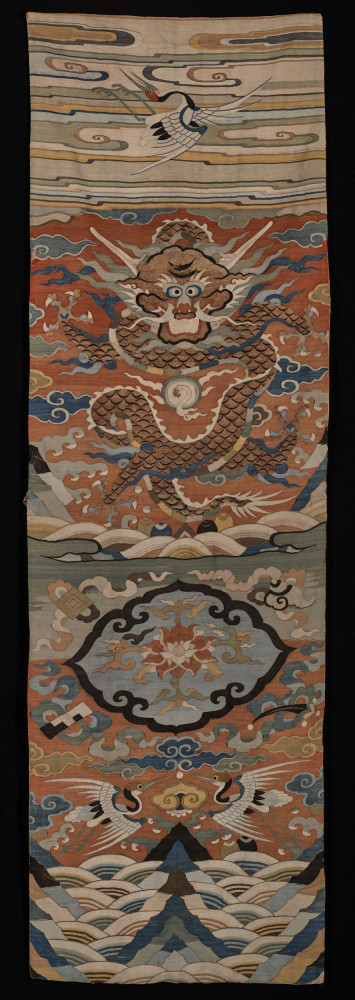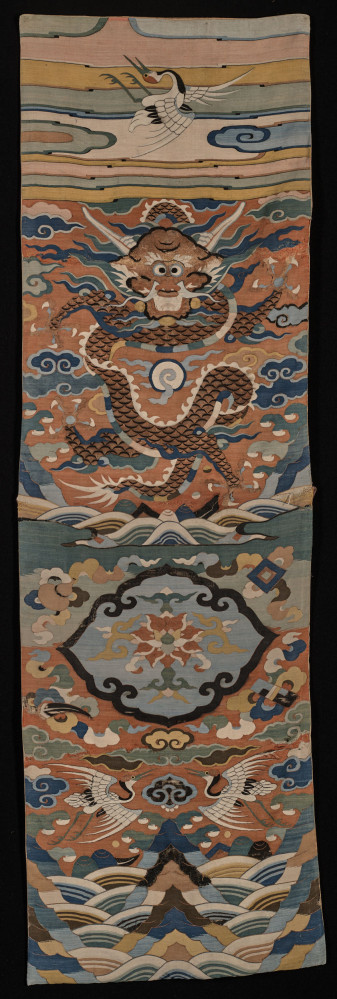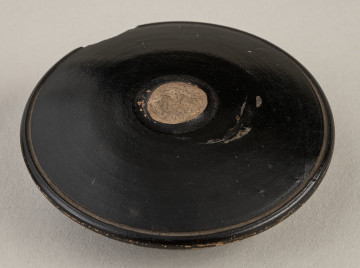
Overlay for a chair
4th quarter of the 18th century
Castle Museum in Łańcut
Part of the collection: Fabrics
Chinese tapestry – a fabric from the times of the Qing dynasty. The composition is entitled All birds pay tribute to a pair of Feng (Fenghuang) birds. At the centre of the composition, there is a pair of ‘royal birds’ – Fenghuang – surrounded by images of other birds, plants and inanimate nature, each having its symbolic meaning. The fabric now consists of two parts. As a result of research carried out by Małgorzata Podkańska in 2016, it was found that it was originally a fabric with an approximate size of 350 x 750 cm. It was created by sewing together 6 vertical strips of fabric. The composition depicts: from the left – vegetation and birds; at the bottom – a hillside covered with willows, almond trees, bamboos and peony bushes, orchids, chrysanthemums and small flowers. Each of the trees provides shelter for many species of birds: kingfisher, ibis, cranes, jays and pairs of parrots, swallows and many other small species. The centre is occupied by the legendary, fancifully feathered Feng bird taking flight from the rock. The tail feathers are worked out very intricately and take up half the height of the tapestry. The composition also includes peacocks, their beaks open as if they were calling one another. The composition is dynamic and testifies to the technical and artistic mastery of the craftsmanship. The birds were depicted in elaborate poses – soaring, swimming, balancing. The care with which is conveyed the structure and texture of the feathers is astounding. The background is mostly brick-red, the present colours of the birds and vegetation are silvery white and creamy whites, bleached blues and navy blues, greens and a greenish metallic thread imitating the effect of peacock feathers. Hand embroidery on paper backing, partially convex, on laid cotton threads. Silk embroidery threads, partly untwisted and cotton ‘string’ – a stitch called ‘satin’ or ‘laid’. Background fully embroidered with cotton thread applied in the shape of rosettes. The whole is maintained in shades of beige and grey. The border of the tapestry made of cotton thread and strips of paper, originally with gilding – motif of stylised dragons and birds. The details of the acquisition of this tapestry are not known. However, it is known when it was installed in the panels of the Column Hall of the Castle in Łańcut – at the turn of the 17th and 18th centuries. The tapestry dates to the end of the 17th and the first half of the 18th century. This was found through technical, formal, iconographic and symbolic analysis. The object currently located in the Column Hall in the Castle Museum in Łańcut is a replica of the tapestry. The process of creating the replica was also interesting and laborious, it required making a high-resolution digital photography. First, the background was removed from this reproduction, and only the embroidery was left. Then retouching and painting additions was made on the prints by hand. The replica reproduces the original background colour from 200 years ago. The secured, original tapestry await further conservation work and the creation of a separate gallery.
Object type
Fabrics
Technique
embroidery, weaving
Material
silk (fabric)
Creation time / dating
Creation / finding place
Owner
Castle Museum in Łańcut
Identification number
Location / status

4th quarter of the 18th century
Castle Museum in Łańcut

4th quarter of the 18th century
Castle Museum in Łańcut

19th (?) century
Castle Museum in Łańcut
DISCOVER this TOPIC
National Museum in Szczecin
DISCOVER this PATH
Educational path